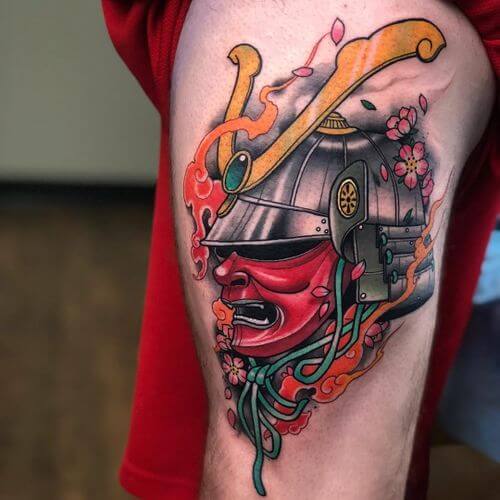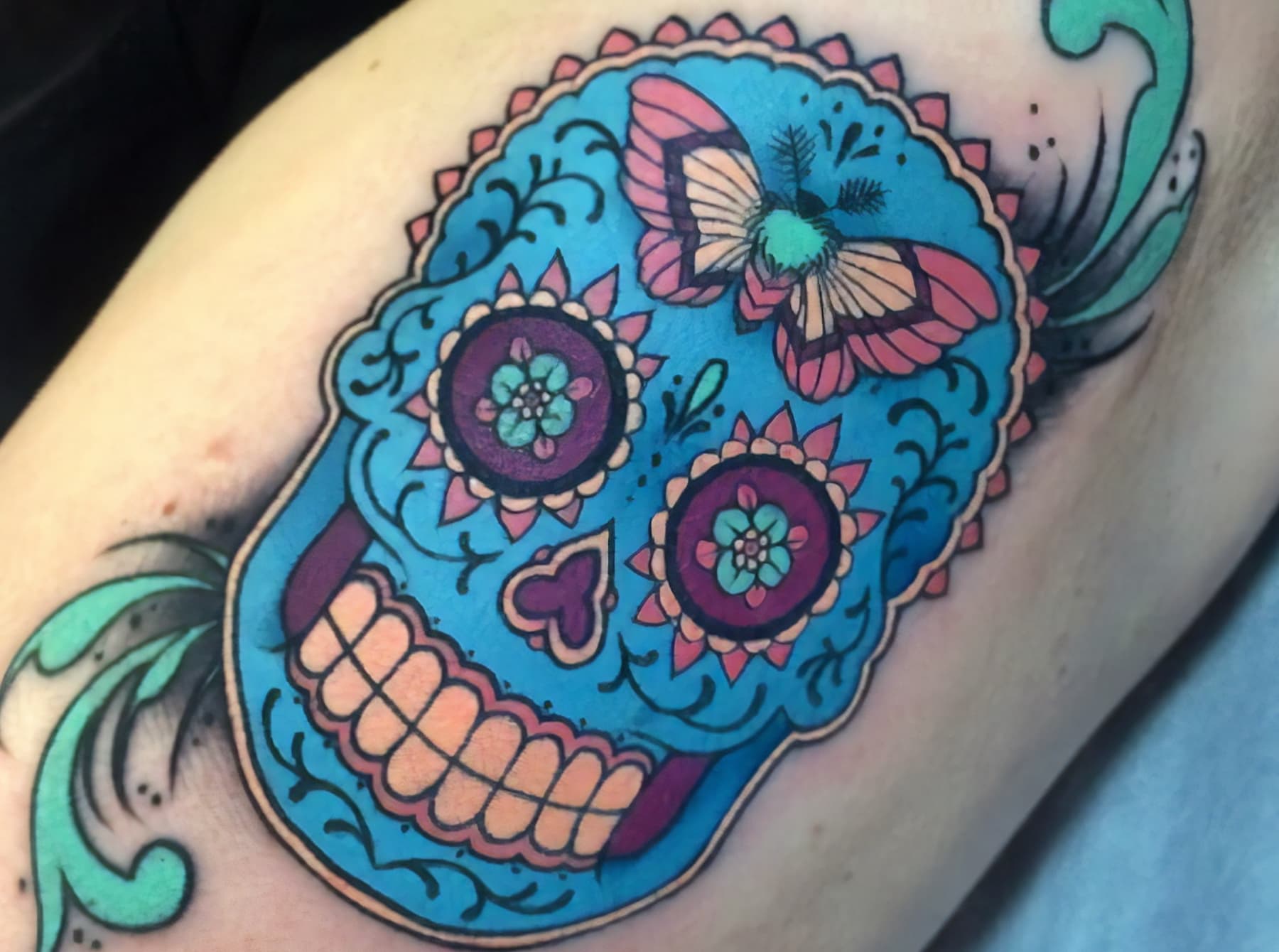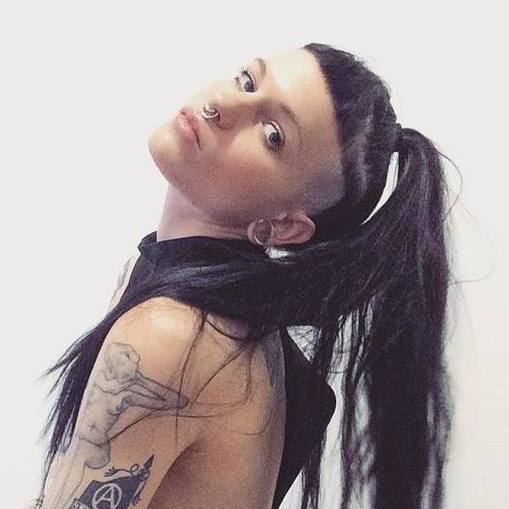
New School Tattoos: Origins, Styles and Artists
Contents:
- Мanagement
- Styles
- New school

In this article, we explore the origins, styles, and artists who work within the New School tattoo aesthetic.
- Bright tones, eye-catching characters, round shapes and cartoony concepts are all part of the New School tattoo style.
- Similar to American traditional tattoos or neo-traditional tattoos, New School tattoos use heavy black lines to prevent color from spreading, and they also use large shapes and designs to make tattoos easy to read.
- The New School tattoo is heavily influenced by video games, comics, TV shows, Disney movies, anime, graffiti and more.
- Michela Bottin, Kimberly Wall, Brando Chiesa, Laura Anunnaki, Lilian Raya, Logan Barracuda, John Barrett, Jesse Smith, Mosh, Jamie Rice, Quique Esteras, Andrés Acosta, and Oash Rodriguez use aspects of the New School tattoo.
- The origins of the new school of tattooing
- New School Tattoo Styles
- New School Tattoo Artists
Intensely bright tones, eye-catching characters, rounded shapes, and cartoonish concepts make the New School tattoo a very lively aesthetic that draws inspiration from a wide variety of places for its style. With the foundations of American Traditional, Neotraditional, as well as anime, manga, video games, and comics, there are a few things this style doesn't borrow from. In this guide, we'll take a look at the origins, stylistic influences, and artists that make up this incredibly intense New School tattoo aesthetic.
The origins of the new school of tattooing
One of the few things people don't notice about New School tattoos is how its foundations are cemented within the American tradition. Many of the rules laid down long ago by traditional tattoo artists help legibility and healthy aging of tattoos. Bold black lines help prevent color bleed, large shapes and patterns make it easy to create highly readable tattoos; this is something the New School holds close to its heart. There is also a fairly obvious connection to Neo Traditional; you can see the influence of Art Nouveau and Japanese aesthetics on artists, usually quite clearly. However, the differences are also easy to see. With technological advances in ink pigments, tattoo artists can use vibrant colors ranging from fluorescent to neon. Considering where New School draws its iconography from, these hues help reinforce the cartoonish aspects of the style. And one more thing: The New School tattoo is mostly influenced by diverse pop culture. Gamers ink, comic book fans, anime and manga characters… they all find a home here.
The true origins of the New School tattoo are lost in translation and in time due to the influx of client requests, changes in the industry and the generally closed and exclusive atmosphere of the tattoo community. Some people argue that the New School style has its origins in the 1970s, while others see the 1990s as the true emergence of the aesthetic we know now. Despite this, Marcus Pacheco is considered by most tattoo artists to be one of the main precursors of the genre, however, some ink historians consider this change in style not only an evolution of the artist and art, but also caused by a change in the tastes of clients. It should be noted that the 90s certainly saw a resurgence of real interest in mass pop culture; we can see the ink of that era, including a large number of cartoons and Disney influences, as well as graffiti compositions and more. Betty Boop, tribal tattoos, Fresh Prince of Bel Air, Pokemon, Zelda; these are some of the most iconic ink ideas from the 90s, a time when concepts merged and collided.
It actually makes sense that at the end of the 20th century, pop culture has become the vanguard of aesthetic culture and change, and this information will be constantly disseminated in new formats. In 1995, the Internet was finally fully commercialized, and users received an incredible amount of visual and intellectual material, more than ever before. Perhaps the most well-known ISP, known for its 'You've Got Mail' slogan, is AOL, which in itself is a testament to the power of the internet and pop culture. Although the Internet appeared in the late 1980s, the 90s and early 2000s were a time of new ideas, styles, and an abundance of information and inspiration that influenced many artists and industries.
There is often a division between American traditional artists and New School artists. The rules, techniques and methods of tattooists are usually closely guarded and only passed down through artists and dedicated students. It was not only the demand for new designs from clients, but also the hope of some artists to progress and share new concepts and ways of working; work outside the rules. With the invention and public integration of the Internet, this promotion has become easier. The traditional American tattoo has been expanded with Neo Trad, New School and a thousand other different styles and has taken on this ancient art form.
New School Tattoo Styles
As mentioned above, neo-traditional modern styles can easily be seen in the New School tattoo as well. But the influence of Japanese aesthetics comes not only from the iconography of Irezumi and Art Nouveau decorative techniques, but also from the culture of video games, comics, and most often also anime and manga. This influence is due not only to the wide public access to the Internet, but also to cable television. While Japanese animation has an incredible history of its own, recognition overseas did not become widespread until Western adaptations, dubs, and networks began using the anime for their own programming. Toonami, which first appeared as a daytime and evening block on Cartoon Network, has featured shows such as Dragon Ball Z, Sailor Moon, Outlaw Star, and Gundam Wing. This was also due to the materialization of highly skilled animation studios such as Studio Ghibli, which partnered with Disney in 1996, providing a fairly new and wide audience. All of these steps helped bring anime, manga, comics, and other Japanese cultural movements to Western fanatics, who then turned to the New School tattooists, the only artists in the industry able or interested in making their wonderful nerd dream tattoos come true.
The same can be said about Disney. In the 1990s, Disney enjoyed a renaissance of its own, producing some of its most famous and beloved films. Aladdin, Beauty and the Beast, The Lion King, The Little Mermaid, Pocahontas, Mulan, Tarzan and many more have been part of this new life in the Disney repertoire. And even today, these iconic films form the backbone of the New School's tattoo portfolio. One thing that can be easily said about the style is the obvious passion behind the work; many contemporary works of the New School are based on childhood nostalgia or infatuation. Comic book heroes, animated characters - all these are perhaps the most common concepts within the style. And it makes sense; tattoos are often a way to show the outside world your connections or deepest passions. There is a devotion within the New School tattoo and the industry in general that can be seen in very few other communities, but those other super dedicated communities definitely include gamers, comic book and graphic novel lovers, and anime fans. In fact, Japan has a special word for this type of person: otaku.
While cartoons are by far the biggest influence on New School tattoos, graffiti is another big piece of the pie. Despite the huge popularity of graffiti in the underground of the 1980s, the popularity of graffiti reached an all-time high in the 90s and 2000s. Wild Style and Style Wars were two films that brought public attention to street art in the early 80s, but with the rise of artists like Obie and Banksy, graffiti quickly became a mainstream art form. New School tattoo artists have used street artists' bright colors, shadows, and soaring graceful lines as inspiration for their own work, and sometimes the fonts themselves can be part of the design.
New School Tattoo Artists
Due to the easy adaptability of the New School tattoo style, many artists choose to work in this style and influence it with their personal tastes and passions. Michela Bottin is an artist known for her perfect recreations of many Disney characters, from Lilo and Stitch to Hades from Hercules, as well as Pokémon creatures and anime stars. Kimberly Wall, Brando Chiesa, Laura Anunnaki, and Lilian Raya are also known for their highly colorful writing, including many manga inspirations. Logan Barracuda, John Barrett, Jesse Smith, Mosh and Jamie Rhys are New School representatives with surreal cartoon shapes and styles. Artists such as Quique Esteras, Andrés Acosta and Oas Rodriguez tend to combine their work with neo-traditional and realistic styles, creating a completely new look of their own.
Again, based on traditional American and neo-traditional tattooing, the New School tattoo is a remarkably strong aesthetic that draws on pop culture to create an entirely new style that resonates deeply with many. The story, stylistic qualities, and artists in the New School tattoo technique have created a genre that gamers, anime lovers, and comic book fans adore; this style carved out a place in the community just for them and many others.
JM
By Justin Morrow
Leave a Reply